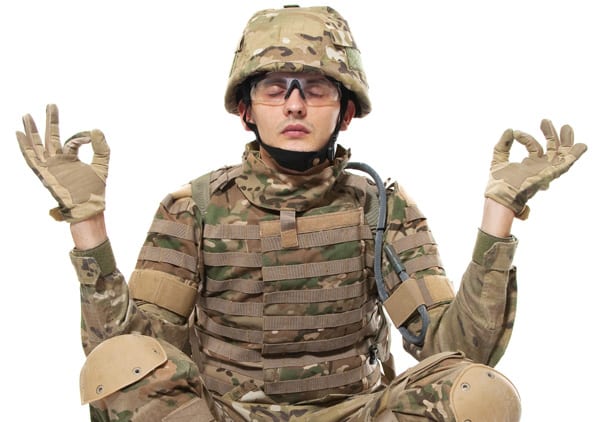 This nation’s military veterans and wounded warriors continue to fight, long after they come off the battlefields. They fight to be whole again and to reclaim their physical and psychological health. Many forms of massage and bodywork can help them do just that.
This nation’s military veterans and wounded warriors continue to fight, long after they come off the battlefields. They fight to be whole again and to reclaim their physical and psychological health. Many forms of massage and bodywork can help them do just that.
Therapeutic Massage
With its ability to meld body and mind, massage is an excellent way for veterans to reintegrate. Not only can this kind of therapeutic touch address the physical wounds, it can help bring a sense of normalcy back into daily life. “Gratifying physical experiences, such as massages … may be experiences that patients build up that are not contaminated by trauma, and which may serve as a core of new gratifying experiences,” writes Bessel van der Kolk, author of Traumatic Stress.
Research on massage and veterans, funded by the National Institutes of Health, has shown considerable promise for this hands-on therapy. An initial 2014 study found that veterans reported significant reductions in physical pain, physical tension, irritability, anxiety/worry, and depression after massage. As a result, researchers are hoping to show in Phase 2 of their study that massage could diminish our veterans’ needs for opiods for pain management, a significant concern for the US Department of Defense and the veterans themselves.
Many of our military personnel returning from battle zones come home less than whole. In cases of amputation, massage can help control edema, deal with neuromas, improve skin health, and loosen scar tissue. For more on this topic, read “David’s Heroes” in the November/December 2014 issue of Massage Bodywork magazine. Find it online at www.massageandbodyworkdigital.com/i/398416.
When visiting a massage therapist for the first time, expect a comprehensive intake process to facilitate your session. If you are a veteran or wounded warrior, your therapist will want to discuss the extent of your injuries with you, the medical procedures you’ve undergone, and any ongoing health issues, as well as medications you’re currently taking. All of these questions help inform the therapist how to work most effectively and safely with you, so be honest and forthcoming in your responses. As with any massage, be sure to let your therapist know if anything makes you uncomfortable during your session–whether it’s that the room temperature is too hot or the massage pressure is too deep. At any time, you can end the session if the work is too intense or you need a break.
Craniosacral Therapy
Craniosacral therapy (CST) has shown considerable promise in helping military veterans and other posttraumatic stress disorder (PTSD) sufferers. The developer of CST, the late John E. Upledger, DO, OMM, believed this subtle hands-on therapy could make a difference. When he invited veterans to be part of intensive CST programs in 1999, he found that their depression and anxiety levels dropped considerably after the therapy was administered, and that feelings of hopelessness, which had once been pervasive, quickly dissipated.
Further evidence for CST came in 2004-2005, when military personnel returning from duty in combat regions were exposed to the therapy at California’s Naval Hospital Lemoore. “The results were absolutely profound,” says retired commanding officer Sandy DeGroot, who oversaw the program. “It’s very hard for [those returning from active combat zones] to come back fully and be in the present moment. The CST work allowed them to release trauma held in the body.”
Reflexology
According to author Paula Stone, reflexology is a highly effective therapy for PTSD, a condition that affects more than 5.2 million Americans every year. “Acute sustained stress erodes the very fabric of our being, while acute trauma can tear it. Whether prolonged or sudden, traumatic life experiences wound a person in body, emotions, mind, and soul, and can result in PTSD. Compassionate bodywork, including reflexology, can help heal the body and the person.”
She says two benefits of using reflexology for clients with PTSD are (1) it can be utilized when massage and other touch therapies cannot and (2) the client remains clothed. “Reflexology improves the client’s sense of well-being, improves sleep, reduces anxiety, and often reduces the need for pain medications, especially following surgery or cancer treatments.” Stone says foot reflexology improves the function of all body systems. “Immediately noticeable are improvements in the flow of bioelectrical energy, blood, lymph, and nerve impulses. Reflexology also works energetically by balancing the body’s energy systems. It works in harmony with a broad spectrum of energy therapies, such as polarity therapy and Asian medicine.”
Finding Help
Other modalities that have offered relief for members of our nation’s military include breath work, Healing Touch, myofascial release, reiki, Therapeutic Touch, trauma touch therapy, and even yoga. More are being added to the list every day.
If you or someone you know is a veteran or wounded warrior, and is suffering, reach out. Contact your local Veterans Affairs offices, visit the Wounded Warrior Project (www.woundedwarriorproject.org) or Comfort for America’s Uniformed Services (CAUSE; www.cause-usa.org), and make an appointment with your massage therapist or bodyworker.
For more information on PTSD, visit the National Center for PTSD, US Department of National Veterans Affairs, at www.ptsd.va.gov.
Source: ABMP

